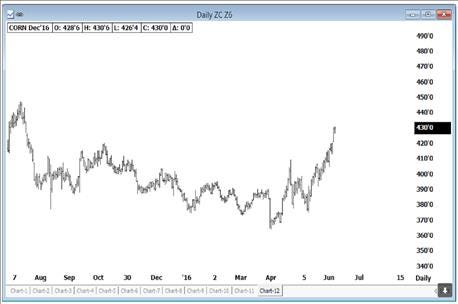
I anticipate Monday's price action in live cattle to have been an anomaly. The hyper volatility continues to reflect the disconnect between the sound cash dealings and frail futures structure.
It may be slow, but eventually I perceive the stronger cash market, larger kills and persistent movement of beef will go a long way in helping to offset the increase in inventory.
While I'm hesitant to suggest that high frequency traders were involved with yesterday's movement, the entity or entities that appear to be pressuring the futures may have attempted their last to force prices lower with no avail.

Corn is marching up so steadily it suggests something is wrong with this new crop.
Again, there is nothing bullish, but the bearishness that is reflected in the futures does not appear to be supported by the cash market and beef movement.
A close this week above $123.42 or below $119.20 will go a long way in deciding whether the bear market is complete or on the verge of resuming.
Feeder cattle still sidling
I perceive thin market conditions to be primarily at fault for Monday's sharp feeder cattle decline. While there is nothing bullish feeder cattle, I perceive the bearishness has been traded.
Range-bound trading is much more likely than a directional move one way or the other. I anticipate August feeders to trade back to the $152.20 area before finding much resistance. There is a strong seasonal tendency for feeders to trade higher at the end of this week through the second week of July.
Even if one had to be short, it may be prudent to see if traders don't allow prices to move somewhat higher before doing so.
Corn moving up
December corn met an objective anticipated months ago on Monday. The gap up and close on the high of the day had me expecting follow through, and indeed we have seen that at midday Tuesday. The oscillator is at a new high as is price. This also leads me to anticipate further price advancement.
There is something not quite right with the corn crop. Although the progress report shows all is well, the price advancement suggests it is not.
My analysis suggests that emergence wasn’t as good as it could have been and there remains some standing water issues in area. Weather forecasts continue to suggest higher summer temperatures.
As of Monday night I said I do not recommend selling futures to hedge new-crop corn. I urge producers to sell all the old crop they have now. I urge producers to not use futures or options to hedge new crop corn, but to instead book it with your elevator.
If long positions were established on any of the many recommendations, one may want to do something to solidify those gains.
For making sales, I recommend selling all of your old crop now and only booking what you want at the elevator for new crop. I do not recommend using futures or options at this time to hedge prices. My analysis suggests to not be too quick to call a top to this market.
An investment in futures contracts is speculative, involves a high degree of risk and is suitable only for persons who can assume the risk of loss in excess of their margin deposits. You should carefully consider whether futures trading is appropriate for you in light of your investment experience, trading objectives, financial resources and other relevant circumstances. Past performance is not necessarily indicative of future results.
About the Author(s)
You May Also Like




